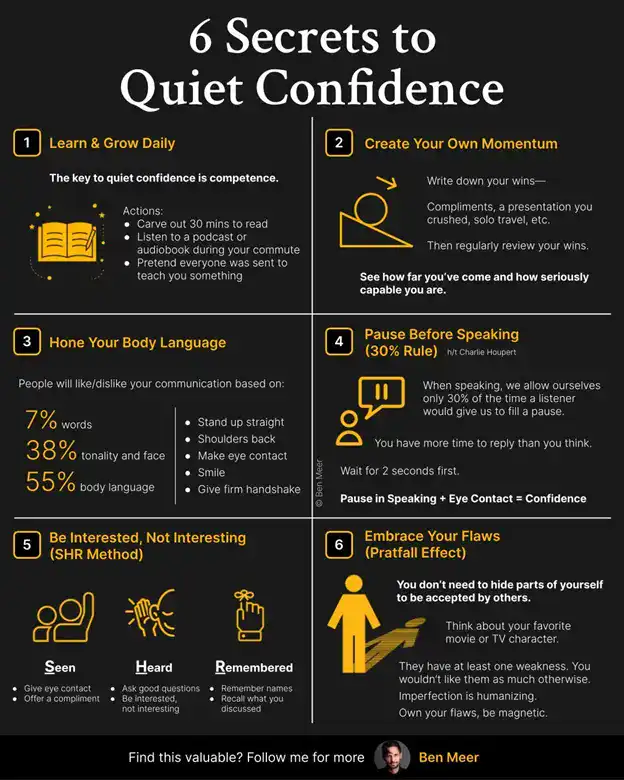Confidence isn’t about being the loudest person in the room—it’s about embodying self-assurance in a way that feels authentic and unforced. The infographic 6 Secrets to Quiet Confidence outlines practical strategies to build this subtle yet powerful trait. Below, we expand on each secret to help you develop a quiet confidence that resonates in both personal and professional settings.

1. Learn & Grow Daily
Quiet confidence stems from competence. When you consistently invest in your knowledge and skills, self-doubt naturally diminishes.
How to Implement:
- Dedicate 30 minutes daily to reading. Whether it’s industry-related books, philosophy, or biographies, regular learning fuels intellectual confidence.
- Turn downtime into growth opportunities. Listen to podcasts or audiobooks during commutes or chores.
- Adopt a student mindset. Approach every interaction as a chance to learn something new. As the infographic suggests, “Pretend everyone was sent to teach you something.”
By prioritizing growth, you’ll develop a quiet assurance rooted in your expanding expertise.
2. Create Your Own Momentum
Confidence grows when you acknowledge your progress. Many people focus on their shortcomings, but reflecting on your wins reinforces self-belief.
How to Implement:
- Keep a “win journal.” Document compliments, successful presentations, or personal achievements like solo travel.
- Review your wins regularly. This practice reminds you of your capabilities and builds resilience against imposter syndrome.
As the infographic notes, “See how far you’ve come and how seriously capable you are.”
3. Hone Your Body Language
Nonverbal cues speak louder than words. Research cited in the infographic breaks down communication impact:
- 7% words
- 38% tonality and facial expressions
- 55% body language
How to Implement:
- Stand tall. Straight posture and shoulders back project assurance.
- Make eye contact. It conveys engagement and confidence.
- Smile and offer a firm handshake. These small gestures leave a lasting positive impression.
By aligning your body language with confidence, you’ll feel more self-assured—and others will perceive you that way too.
4. Pause Before Speaking (The 30% Rule)
Nervousness often leads to rushed speech. The infographic credits Charlie Houpert’s 30% Rule: We typically use only 30% of the pause time listeners are willing to tolerate before feeling uncomfortable.
How to Implement:
- Wait 2 seconds before responding. This brief pause projects thoughtfulness.
- Combine pauses with eye contact. This duo signals calm confidence.
Slowing down your speech not only makes you appear more composed but also gives you time to formulate better responses.
5. Be Interested, Not Interesting (The SHR Method)
Quietly confident people focus on others, not themselves. The Seen, Heard, Remembered (SHR) method outlines how to make meaningful connections:
How to Implement:
- Seen: Give eye contact and offer genuine compliments.
- Heard: Ask thoughtful questions and listen actively. “Be interested, not interesting.”
- Remembered: Recall names and details from past conversations.
This approach shifts the focus from self-promotion to building rapport, which naturally enhances your likability and confidence.
6. Embrace Your Flaws (The Pratfall Effect)
Perfection is neither achievable nor relatable. The Pratfall Effect suggests that minor flaws make you more human and likable.
How to Implement:
- Acknowledge your imperfections. Think of your favorite fictional characters—their flaws make them endearing.
- Own your quirks. Whether it’s a nervous laugh or a niche hobby, leaning into authenticity fosters genuine connections.
As the infographic reminds us, “You don’t need to hide parts of yourself to be accepted by others.”
Final Thoughts
Quiet confidence isn’t about arrogance or dominance—it’s the art of trusting yourself without needing external validation. By integrating these six secrets into your daily life, you’ll cultivate a steady, unshakable self-assurance that speaks volumes without saying a word.
Start small: pick one secret to focus on this week, and observe the shift in how you feel—and how others respond to you. Confidence is a journey, not a destination.
Find this valuable? Follow me for more insights on personal growth and self-mastery.

